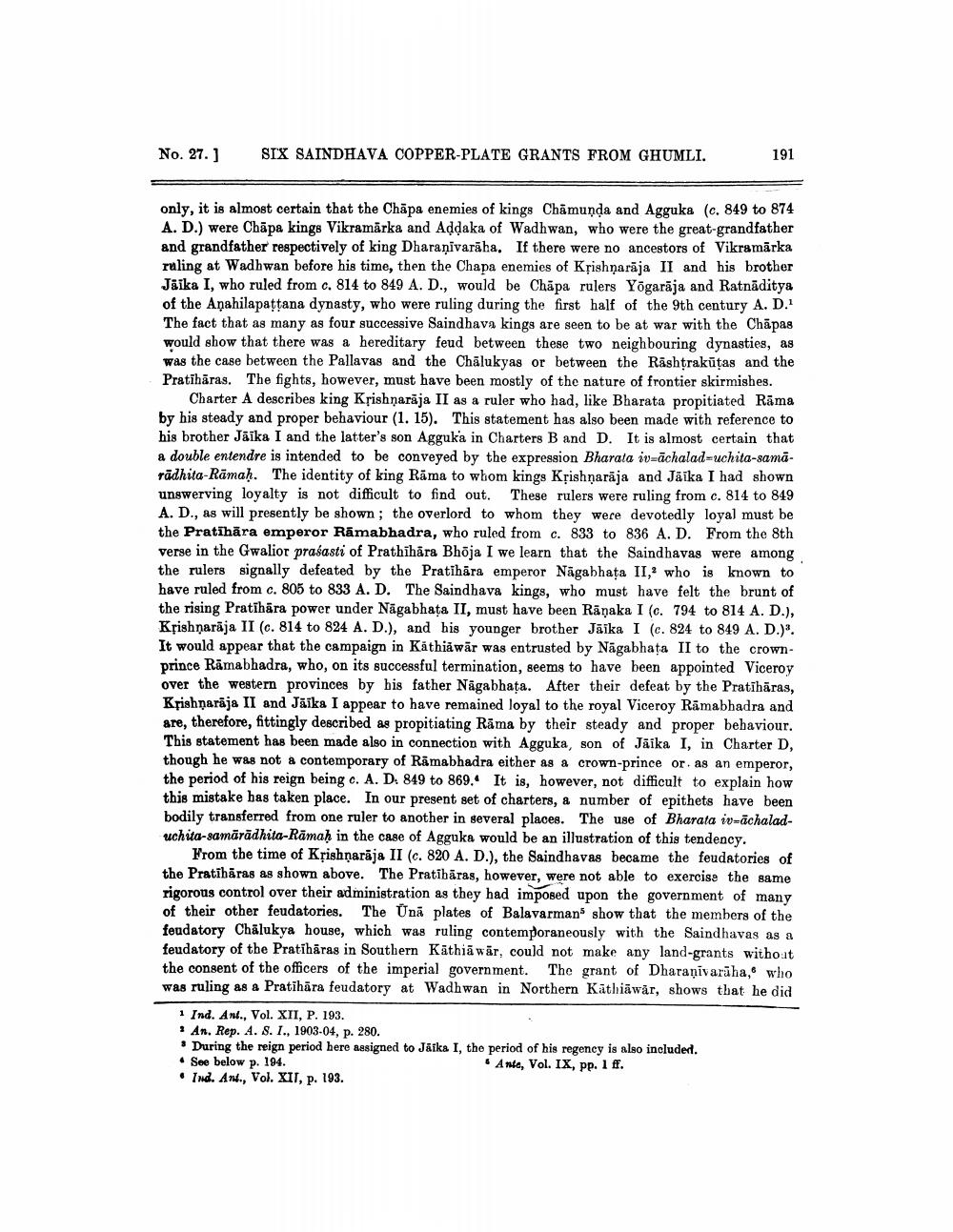________________
No. 27. ]
SIX SAINDHAVA COPPER-PLATE GRANTS FROM GHUMLI.
191
only, it is almost certain that the Chapa enemies of kings Chamunda and Agguka (c. 849 to 874 A. D.) were Chapa kings Vikramärka and Adḍaka of Wadhwan, who were the great-grandfather and grandfather respectively of king Dharaṇīvaraha. If there were no ancestors of Vikramarka ruling at Wadhwan before his time, then the Chapa enemies of Krishnaraja II and his brother Jaika I, who ruled from c. 814 to 849 A. D., would be Chapa rulers Yogaraja and Ratnaditya of the Anahilapaṭṭana dynasty, who were ruling during the first half of the 9th century A. D.1 The fact that as many as four successive Saindhava kings are seen to be at war with the Chapas would show that there was a hereditary feud between these two neighbouring dynasties, as was the case between the Pallavas and the Chalukyas or between the Rashtrakutas and the Pratihāras. The fights, however, must have been mostly of the nature of frontier skirmishes.
Charter A describes king Krishnaraja II as a ruler who had, like Bharata propitiated Rama by his steady and proper behaviour (1. 15). This statement has also been made with reference to his brother Jäika I and the latter's son Agguka in Charters B and D. It is almost certain that a double entendre is intended to be conveyed by the expression Bharata iv-achalad-uchita-samaradhita-Ramaḥ. The identity of king Rama to whom kings Krishnaraja and Jäika I had shown unswerving loyalty is not difficult to find out. These rulers were ruling from c. 814 to 849 A. D., as will presently be shown; the overlord to whom they were devotedly loyal must be the Pratihāra emperor Rāmabhadra, who ruled from c. 833 to 836 A. D. From the 8th verse in the Gwalior prasasti of Prathihara Bhōja I we learn that the Saindhavas were among the rulers signally defeated by the Pratihāra emperor Nagabhața II, who is known to have ruled from c. 805 to 833 A. D. The Saindhava kings, who must have felt the brunt of the rising Pratihāra power under Nagabhaṭa II, must have been Rāņaka I (c. 794 to 814 A. D.), Krishnaraja II (c. 814 to 824 A. D.), and his younger brother Jaika I (c. 824 to 849 A. D.)". It would appear that the campaign in Kathiawar was entrusted by Nagabhata II to the crownprince Ramabhadra, who, on its successful termination, seems to have been appointed Viceroy over the western provinces by his father Nagabhata. After their defeat by the Pratihāras, Krishnaraja II and Jaika I appear to have remained loyal to the royal Viceroy Ramabhadra and are, therefore, fittingly described as propitiating Rama by their steady and proper behaviour. This statement has been made also in connection with Agguka, son of Jaika I, in Charter D, though he was not a contemporary of Ramabhadra either as a crown-prince or as an emperor, the period of his reign being c. A. D: 849 to 869. It is, however, not difficult to explain how this mistake has taken place. In our present set of charters, a number of epithets have been bodily transferred from one ruler to another in several places. The use of Bharata iv-achaladuchita-samaradhita-Ramaḥ in the case of Agguka would be an illustration of this tendency.
From the time of Krishnaraja II (c. 820 A. D.), the Saindhavas became the feudatories of the Pratihāras as shown above. The Pratihāras, however, were not able to exercise the same rigorous control over their administration as they had imposed upon the government of many of their other feudatories. The Una plates of Balavarmans show that the members of the feudatory Chalukya house, which was ruling contemporaneously with the Saindhavas as a feudatory of the Pratihāras in Southern Kathiawar, could not make any land-grants without the consent of the officers of the imperial government. The grant of Dharaṇīvaraha, who was ruling as a Pratihāra feudatory at Wadhwan in Northern Käthiäwär, shows that he did
1 Ind. Ant., Vol. XII, P. 193.
An. Rep. A. S. I., 1903-04, p. 280.
During the reign period here assigned to Jaika I, the period of his regency is also included. See below p. 194.
Ante, Vol. IX, pp. 1 ff.
Ind. Ant., Vol. XII, p. 193.




